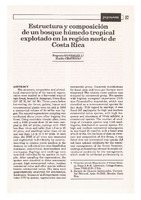Estructura y composición de un bosque húmedo tropical explotado en la región norte de Costa Rica
Abstract
The structure, composition and silvicultural characteristics of the natural regeneration were studied in a harvested tropical rainforest, located in Sarapiqui, Costa Rica (10º 32' N, 84º 04' W). Three years before harvesting the forest, palms, lianas and noncommercial plants were cut and in 1984 a commercial volume of 40 m3/ha was logged. The natural regeneration samplíng was conducted three years after logging the forest. Using concentric circular plots, trees with a DBH greater than 10 cm were sampled in 100 m2 plots; saplings with DBH less than 10 cm and taller than 1.5 m in 25 m2 plots, and seedlings taller than 30 cm and less than 1.5 rp. in 4 m2 plots. In each plot, the DBH of all trees was measured and registered individually by species. According to relative crown position in the stratum, an individual tree was classified as dominant, codominant, intermediate and overtopped. Saplings and seedlings were recorded individually by species in each plot. After sampling the regeneration, the species were classified in three commercial groups: high commercial value, median commercial value and other species without known commercial value. The data were quantitatively analyzed for abundance, dominance, frequency and importance value index (IVI) by species, regeneration size and commercial group. Diametric distributions for basal area and trees per hectare were elaborated. The relative crown position was analyzed by the cornmerciál group. The species with highest ecological importance (IVI) was Pentaclethra macroloba , which was classified as a noncommercial species for this study. With regard to saplings, it was found 247 saplings/ha for high and medium commercial value species, with high frequency and abundance of Virola sebifera , a commercial species. The number of seed-lings of valuable species was 1160 seedlings/ha, distributed on several species. For high and medium commercial valq.especies in was found 25 trees/ha, with a basal area of 2.75 m2/ha. On the basis of data on structure and composition of this forest, it was found that the commercial tree species did not have optimal conditions for the sustained management of the forest; however, saplings and seedlings showed favorable silvicultural conditions for the management, which could be attributed preliminarily to the elimination of palms and lianas performed three years before harvesting the forest.
Collections
- Revista Yvyraretá [360]
The following license files are associated with this item:




